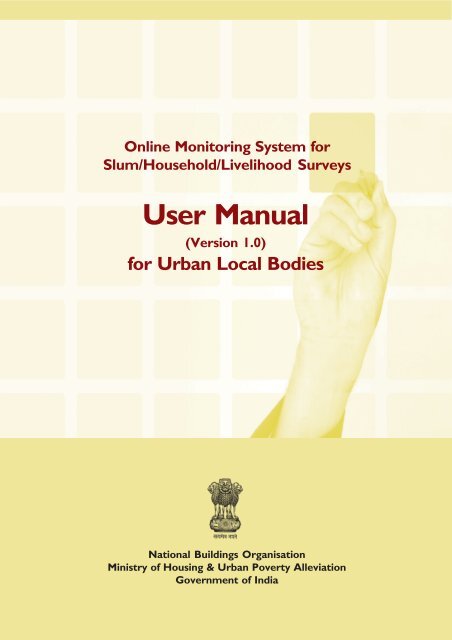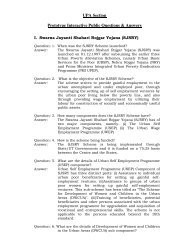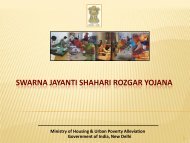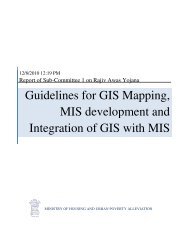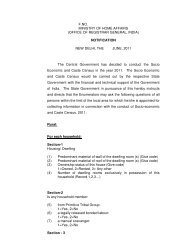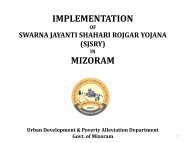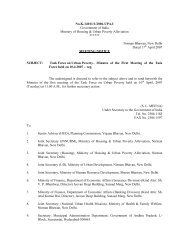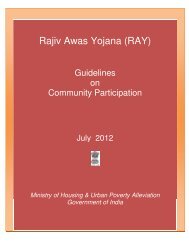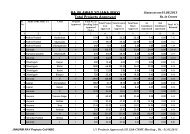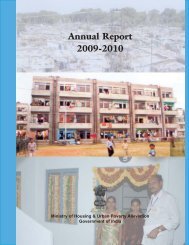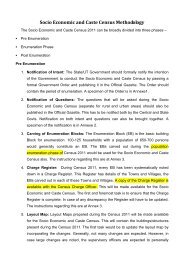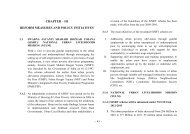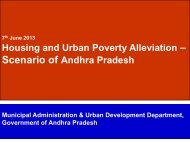User Manual - Ministry of Housing & Urban Poverty Alleviation
User Manual - Ministry of Housing & Urban Poverty Alleviation
User Manual - Ministry of Housing & Urban Poverty Alleviation
Create successful ePaper yourself
Turn your PDF publications into a flip-book with our unique Google optimized e-Paper software.
Online Monitoring System forSlum/Household/Livelihood Surveys<strong>User</strong> <strong>Manual</strong>(Version 1.0)for <strong>Urban</strong> Local BodiesNational Buildings Organisation<strong>Ministry</strong> <strong>of</strong> <strong>Housing</strong> & <strong>Urban</strong> <strong>Poverty</strong> <strong>Alleviation</strong>Government <strong>of</strong> India
Copyright 2011, <strong>Ministry</strong> <strong>of</strong> <strong>Housing</strong> & <strong>Urban</strong> <strong>Poverty</strong> <strong>Alleviation</strong>, Government <strong>of</strong>©India, New DelhiAll rights reserved. No part <strong>of</strong> this publication may be reproduced, stored in a retrievalsystem, or transmitted in any form or by any means, electronic, mechanical, photocopying,recording or otherwise, without the prior written permission <strong>of</strong> the copyright owner.
<strong>User</strong> <strong>Manual</strong> (Version 1.0) for <strong>Urban</strong> Local Bodies1. Overview1.1 PurposeThe purpose <strong>of</strong> this document is to present a detailed description <strong>of</strong> the Online MonitoringSystem for Slum/Household/Livelihood Surveys. This explains the purpose and features <strong>of</strong>the system, the interfaces <strong>of</strong> the system, what the system will do, the constraints underwhich it must operate. This document is intended for both the stakeholders and the developers<strong>of</strong> the system.1.2 BackgroundSocio-economic surveys are being conducted by the State Governments and <strong>Urban</strong> LocalBodies to formulate a plan for the improvement <strong>of</strong> the conditions <strong>of</strong> slums and slum dwellers.The statistical data thus collected from surveys is being maintained in their respectivedatabases. However, it is found that the survey data collected is not in a uniform formatmaking it difficult to collate and analyze the data at a single source e.g. <strong>Ministry</strong> <strong>of</strong> <strong>Housing</strong>and <strong>Urban</strong> <strong>Poverty</strong> <strong>Alleviation</strong>. Therefore, it becomes essential that for administrative reasons,the data collected through surveys is maintained in a central database following auniform format and accessible from anywhere.The necessity <strong>of</strong> a National-level information system has led to NBO, MoHUPA. Undertakingthe following actions:• Design <strong>of</strong> formats for conducting Slum/Household/Livelihood surveys and circulationto all the States and Cities.• Circulation <strong>of</strong> detailed guidelines indicating the instructions to be followed for conductingthe surveys. Development <strong>of</strong> National-level MIS and its maintenance has beenassigned to Centre for Good Governance(CGG)2. The MISThe Management Information System (MIS), for Slum survey/Household survey/Livelihoodsurvey is an e-tool developed to build a robust information system on infrastructural facilitiesavailable in slums and also about the socio-economic pr<strong>of</strong>ile <strong>of</strong> the households and theirlivelihoods. The system is developed by the Centre for Good Governance (CGG) for <strong>Ministry</strong><strong>of</strong> <strong>Housing</strong> and <strong>Poverty</strong> <strong>Alleviation</strong> (MoHUPA) and maintained on behalf <strong>of</strong> the <strong>Ministry</strong>.This MIS is a databank which enables analysis, monitoring and planning with multi-facetedbenefits such as:• Informed decision making for Planners & Policy makers• Identification <strong>of</strong> the livelihood needs like primary education, training, employmentetc. in each slum area. Decision can be taken on the needs or area <strong>of</strong> focus for development<strong>of</strong> individuals as well as slums.National Buildings Organisation, <strong>Ministry</strong> <strong>of</strong> <strong>Housing</strong> & <strong>Urban</strong> <strong>Poverty</strong> <strong>Alleviation</strong>1
Online Monitoring System for Slum/Household/Livelihood Surveys(c)Livelihood MIS Reports:- No <strong>of</strong> earning members <strong>of</strong> slum households in states/UT’s- Distribution <strong>of</strong> earning members <strong>of</strong> slum households according to age groups in states/UT’s- Distribution <strong>of</strong> earning members <strong>of</strong> slum households according to religion in states/UT’s- Distribution <strong>of</strong> earning members <strong>of</strong> slum households according to employment statusin states/UT’s- Distribution <strong>of</strong> earning members <strong>of</strong> slum households according to distance to place<strong>of</strong> work in states/UT’s, etc..All the reports are drilldown reports and the data can be viewed up to lowest possible level.3. Step by Step guide for MIS3.1 LoginThe URL for accessing Surveys website is http://surveys.cgg.gov.in. The following log-in screenappears, when the user enters the URL. The user has to enter <strong>User</strong>name and Password, in theLOGIN screen, as indicated below:Login Page<strong>User</strong> NamePasswordThe username and password are,<strong>User</strong> Id:
<strong>User</strong> <strong>Manual</strong> (Version 1.0) for <strong>Urban</strong> Local Bodies3.3.1 Add WardWard Master is used to Add and Edit the ward. When the user selects the "Add Ward" masteroption, the following screen is displayed with the list <strong>of</strong> wards, which are already included in themaster:List <strong>of</strong> WardsToAddNewWardToEdittheWardFigure 7If user wants to add new ward to existing ward's list, click on the "Add New Ward" link. That isavailable on right side <strong>of</strong> the screen. A popup screen will open as shown below, wherein the usercan enter the new ward.The user has to enter the Ward name and click on submit button. The ward name thus enteredwill be added to the Ward's list.Enter Ward NameFigure 8If user wants to edit existing Ward details, click on the "Edit" button, which is available on rightside <strong>of</strong> the corresponding ward name. On selecting the edit option, A popup screen will open asshown below, wherein the user can edit the existing entries.The Ward name is displayed within the textbox, which can be modified by the user.Modify Ward NameFigure 9National Buildings Organisation, <strong>Ministry</strong> <strong>of</strong> <strong>Housing</strong> & <strong>Urban</strong> <strong>Poverty</strong> <strong>Alleviation</strong>7
3.3.2 Add SlumOnline Monitoring System for Slum/Household/Livelihood SurveysSlum Master is used to Add and Edit the slum. When the user selects the "Add Slum" option, thefollowing screen is displayed with the list <strong>of</strong> slums, which are already entered.To Add New SlumList <strong>of</strong> SlumsTo Edit the SlumFigure 10If user wants to add new slum to existing slum's list, click on the "Add New Slum" link. That isavailable on right side <strong>of</strong> the screen. A popup screen will open as shown below, wherein the usercan enter the new slum name.The user has to enter the Slum name, select Ward name and click on submit button. The slumname thus entered will be added to the Slum's list.Note: <strong>User</strong> can select multiple wards for a single slum. This can be done by pressingthe Ctrl button + left mouse button simultaneously.Enter SlumNameFigure 11If user wants to edit existing slum details, click on the "Edit" button, which is available on right side<strong>of</strong> the corresponding slum name. On selecting the edit option, A popup screen will open asshown below, wherein the user can edit the existing entries.The Slum name is displayed within the textbox, which can be modified by the user.Modify SlumNameFigure 128
<strong>User</strong> <strong>Manual</strong> (Version 1.0) for <strong>Urban</strong> Local Bodies3.3.3 Add SupervisorSupervisor Master is used to Add and Edit the Supervisor. When the user selects the "Add/EditSupervisor" master option, the following screen is displayed with the list <strong>of</strong> supervisor's, whichare already included in the master.To Add New SupervisorList <strong>of</strong>Supervisor’sTo Edit theSupervisorFigure 13If user wants to add new supervisor to existing supervisor's list, click on the "Add New Supervisor"link. That is available on right side <strong>of</strong> the screen. A popup screen will open as shown below,wherein the user can enter the new supervisor.The user has to enter the Supervisor name and click on submit button. The supervisor name thusentered will be added to the Supervisor's list.Enter Supervisor NameFigure 14If user wants to edit existing Supervisor details, click on the "Edit" button, which is available onright side <strong>of</strong> the corresponding supervisor name. On selecting the edit option, A popup screenwill open as shown below, wherein the user can edit the existing entries.The Supervisor name is displayed within the textbox, that can be modified by the user.Modify Supervisor NameFigure 15National Buildings Organisation, <strong>Ministry</strong> <strong>of</strong> <strong>Housing</strong> & <strong>Urban</strong> <strong>Poverty</strong> <strong>Alleviation</strong>9
3.3.4 Add SurveyorOnline Monitoring System for Slum/Household/Livelihood SurveysSurveyor Master is used to Add and Edit the Surveyor. When the user selects the "Add/EditSurveyor" master option, the following screen is displayed with the list <strong>of</strong> surveyor's, which arealready included in the master.To Add New SurveyorList <strong>of</strong>Surveyor’sTo Edit theSurveyorFigure 16If user wants to add new surveyor to existing surveyor's list, click on the "Add New Surveyor"link. That is available on right side <strong>of</strong> the screen. A popup screen will open as shown below,wherein the user can enter the new surveyor.The user has to enter the Surveyor name and click on submit button. The surveyor name thusentered will be added to the Surveyor's list.Enter Surveyor NameFigure 17If user wants to edit existing Surveyor details, click on the "Edit" button, which is available on rightside <strong>of</strong> the corresponding surveyor name. On selecting the edit option, A popup screen will openas shown below, wherein the user can edit the existing entries.The Surveyor name is displayed within the textbox, that can be modified by the user.Modify Surveyor NameFigure 1810
<strong>User</strong> <strong>Manual</strong> (Version 1.0) for <strong>Urban</strong> Local Bodies3.3.5 City/town map showing slums"City/town map showing slums" in the Master menu is used to upload city/town map showingslums. When the user selects the "City/town map showing slums" from the Masters, the followingscreen is displayed with the map if available.3.4 TransactionsTransactions are the forms for entering the data obtained through surveys. There are two itemsin the main menu i.e. 'slum survey' and ' Household survey'. The option <strong>of</strong> 'Slum survey' shouldbe selected for entering the data <strong>of</strong> slum survey and the option <strong>of</strong> 'Household survey' should beselected for entering the data <strong>of</strong> both household survey and livelihood surveys.3.4.1 Slum SurveyFigure 19Under 'Slum Survey' menu there are three Sub Menus. They are3.4.1.1 Slum Survey Input excluding HH data - This option will be selected if the user intendsto input only Slum level information and automatically get the aggregated House Holddata from Household survey.3.4.1.2 Slum Survey Input including HH data - This option has to be selected if the userintends to input the Households data in the slum survey format instead <strong>of</strong> data aggregationfrom Household survey.3.4.1.3 Variance Report- A variance report is generated to indicate the difference in statistics<strong>of</strong> various indicators for which data has been collected through detailed householdsurvey and the data that has been collected through FGDs/ULBs.The items in the Slum Survey menu are shown in the below diagram.National Buildings Organisation, <strong>Ministry</strong> <strong>of</strong> <strong>Housing</strong> & <strong>Urban</strong> <strong>Poverty</strong> <strong>Alleviation</strong>11
Online Monitoring System for Slum/Household/Livelihood Surveys3.4.1.1 Slum Survey input excluding HH dataThis option will be selected if the user intends to input only Slum level information and automaticallyget the aggregated House Hold data.When the user clicks on the "Slum Survey Input excluding HH data" link, the following screen willbe displayed as shown below.Figure 20Note:For adding only the slum name and its ward name but not survey details click on 'Add slum' under'Masters' Menu shown in figure 10 to 12.As seen in the above screen, provision is given to the user to Add, Edit and Delete the surveydetails.1) Add- This option allows the user to enter for the first time about the details <strong>of</strong> theslum survey information along with particulars <strong>of</strong> slum survey operation. This optionwill be disabled, after the data entry is completed. To complete the unfilled particulars,the user has to select the Edit option.2) Edit- This option allows the user to input the unfilled information and also edit thedetailed slum survey information if required. Editing will be allowed only twice. Thereforeuser has to take precaution to input the information correctly.3) Delete- This option allows the user to delete the slum survey details.1) To add the particulars <strong>of</strong> survey details <strong>of</strong> each slum click on 'Add' against the slum nameshown in figure 20 then the system will forward to next screen as shown in Figure 21.(a ) Adding particulars <strong>of</strong> survey operation12Figure 21
<strong>User</strong> <strong>Manual</strong> (Version 1.0) for <strong>Urban</strong> Local BodiesThe user has to enter the details such as name, date <strong>of</strong> survey, receipt <strong>of</strong> questionnaire and otherfields shown above, against surveyor and supervisor.After clicking on submit button the system will forward to next screen to enter detailed surveydetails as shown in Figure 23Note: After clicking on 'submit' button in each and every screen the system automaticallyforwards to the next screen.The slum survey screens are categorized in to 11 sections as detailed below.• Section I-II• Basic Slum Information• Land status• Section III• Demographic Pr<strong>of</strong>ile• Section IV-VI• <strong>Housing</strong> Status• Land Tenure Status• Economic Status <strong>of</strong> Households• Occupation Status <strong>of</strong> Households• Section VII• Access to Physical Infrastructure facilities• Section VIII-IX• Educational facilities• Health facilities• Section X• Social Welfare facilities• Section XI• Additional Infrastructure requirementNote: Sections <strong>of</strong> the survey form will be displayed in the top portion <strong>of</strong> the screenand the user can go to the required section by selecting the section number.Figure 22Note: The sections III-XI will not be displayed until the screen in section I-II is entered.Even though the user clicks on the other sections, the system automaticallyforward to the section I-II (If Details <strong>of</strong> Basic information is not entered).Note: System will give alerts when the user violates the validations incorporated. Theuser can then, accordingly take appropriate action as per the alert message.Section I-IINational Buildings Organisation, <strong>Ministry</strong> <strong>of</strong> <strong>Housing</strong> & <strong>Urban</strong> <strong>Poverty</strong> <strong>Alleviation</strong>13
Online Monitoring System for Slum/Household/Livelihood SurveysSection I-IIList <strong>of</strong> SectionsIn this screen the user needs to enter the details <strong>of</strong> the slum such as "Ward", "Age <strong>of</strong> slum inyears", "Area <strong>of</strong> the Slum", "Whether located in core city/Town or Fringe are", "Type <strong>of</strong> Areasurrounding Slum", "Physical location <strong>of</strong> the slum", "Is the slum notified", "If notified, year <strong>of</strong> notification","Ownership <strong>of</strong> Land" etc.Section IIIFigure 23Figure 2414
<strong>User</strong> <strong>Manual</strong> (Version 1.0) for <strong>Urban</strong> Local BodiesIn this screen the user needs to enter the demographic pr<strong>of</strong>ile <strong>of</strong> all households in that slum. Thedetails <strong>of</strong> slum population, health, Literacy and education are entered against different castes.Note: The columns 12a to 12e. 12h and 12i rows can be aggregated from householdsurveys.Note: The columns 13a to 13d rows can be aggregated from household surveys.Section IV-VIFigure 25In this screen the user needs to enter the occupation status <strong>of</strong> households in that slum.National Buildings Organisation, <strong>Ministry</strong> <strong>of</strong> <strong>Housing</strong> & <strong>Urban</strong> <strong>Poverty</strong> <strong>Alleviation</strong>15
Online Monitoring System for Slum/Household/Livelihood SurveysSection VIIFigure 26In this screen the user needs to enter the details such as source <strong>of</strong> drinking water, drainage andsewerage facility, sanitation facility used by the households and solid waste management in theslum16
<strong>User</strong> <strong>Manual</strong> (Version 1.0) for <strong>Urban</strong> Local BodiesSection VIII-IXFigure 27In this screen the user needs to enter the Existence <strong>of</strong> Education and Health facilities in that slum.The details <strong>of</strong> Pre-primary school, Primary school, High School, <strong>Urban</strong> health post, Primary healthcentre, government hospital, Maternity Centre, Private clinic, RMP, and Ayurvedic doctor alsoneeds to be entered.National Buildings Organisation, <strong>Ministry</strong> <strong>of</strong> <strong>Housing</strong> & <strong>Urban</strong> <strong>Poverty</strong> <strong>Alleviation</strong>17
Online Monitoring System for Slum/Household/Livelihood SurveysSection XFigure 28In this screen the user needs to enter the Availability <strong>of</strong> Social development /Welfare facilities inthat slum. The details <strong>of</strong> No. <strong>of</strong> Community halls, No. <strong>of</strong> Livelihood centers, No. <strong>of</strong> Street Childrenrehabilitation centers, No. <strong>of</strong> Night Shelters, No. <strong>of</strong> Old age homes; Old age, window, disabledpension holders and other fields shown above are also required to be entered.18
<strong>User</strong> <strong>Manual</strong> (Version 1.0) for <strong>Urban</strong> Local BodiesSection XIFigure 29In this screen the user enters the Additional Infrastructure Requirement facilities in the slum.National Buildings Organisation, <strong>Ministry</strong> <strong>of</strong> <strong>Housing</strong> & <strong>Urban</strong> <strong>Poverty</strong> <strong>Alleviation</strong>19
Online Monitoring System for Slum/Household/Livelihood SurveysEditing particulars <strong>of</strong> survey operationIf user wants to edit existing 'Particulars <strong>of</strong> survey operation' details, click on the "Edit" button,which is available on right side <strong>of</strong> the corresponding slum name as shown in figure 20. On selectingthe edit option, system will forward to the screen as belowList <strong>of</strong>Surveyed datesFigure 30By clicking submit the system forward to next consequent screens i.e to all the 11 sections <strong>of</strong> theslum survey. The description <strong>of</strong> the input in each <strong>of</strong> the sections is same as explained at paragraph3.4.1.1.(a) with all screen shots from Figure 23 to Figure 29.3) To delete slum survey details click on 'Delete' link against slum in the screen shown in Figure 20then the system will forward to next screen as shown in below figure.Figure 31By clicking on Delete button the survey details will deleted and these details will not be availablefurthur.Note:1) Before deleting slum survey details user must delete corresponding house hold data forthat slum otherwise system will not allow deleting slum survey details. However, exceptionalreports will be generated to indicate the records deleted by the ULB.20
3.4.1.2 Slum Survey Input including HH data<strong>User</strong> <strong>Manual</strong> (Version 1.0) for <strong>Urban</strong> Local BodiesThis option has to be selected if the user intends to input the Households data in the slum surveyformat instead <strong>of</strong> data aggregation from Household survey. This option should be used only whenthe ULB is not having the HH survey information.The difference between the first option mentioned at 3.4.1.1 & this is that the user has to inputthe Household data also in the slum survey format.The procedure <strong>of</strong> the data entry and the sequence <strong>of</strong> input transactions are same as detailedunder section 3.4.1.1.The transactions or screens where there is a change from what is explained in the earlier sectionare mentioned hereunder:Section IIIIn this screen the user needs to enter the demographic pr<strong>of</strong>ile <strong>of</strong> all households in that slum. Thedetails <strong>of</strong> slum population, health, Literacy and education are entered against different castes. (Inthe section 3.4.1.1., the below information is disabled for data entry as the information is gettingaggregated from the HH survey)Figure 32National Buildings Organisation, <strong>Ministry</strong> <strong>of</strong> <strong>Housing</strong> & <strong>Urban</strong> <strong>Poverty</strong> <strong>Alleviation</strong>21
Section IV-VIOnline Monitoring System for Slum/Household/Livelihood SurveysIn this screen the user needs to enter the Structure <strong>of</strong> all dwelling units, number <strong>of</strong> dwelling unitswith electricity, land tenure status <strong>of</strong> dwelling units, economic status <strong>of</strong> households, and occupationstatus <strong>of</strong> households in that slum. (In the section 3.4.1.1., the below information is disabledfor data entry as the information is getting aggregated from the HH survey)Figure 3322
<strong>User</strong> <strong>Manual</strong> (Version 1.0) for <strong>Urban</strong> Local BodiesSection VIIIn this screen the user needs to enter the details such as source <strong>of</strong> drinking water, drainage andsewerage facility, sanitation facility used by the households and solid waste management in theslum. (In the section 3.4.1.1., the below information is disabled for data entry as the information isgetting aggregated from the HH survey)Figure 34National Buildings Organisation, <strong>Ministry</strong> <strong>of</strong> <strong>Housing</strong> & <strong>Urban</strong> <strong>Poverty</strong> <strong>Alleviation</strong>23
3.4.1.3 Variance ReportOnline Monitoring System for Slum/Household/Livelihood SurveysWhen user clicks on "Variance Report", the list <strong>of</strong> slums will be displayed along with an option toview variance report, the screen is displayed as below.Figure 34 (a)To view variancereportWhen user clicks on View Report option against the slum, the variance report <strong>of</strong> correspondingslum will be displayed, as belowFigure 34 (b)24
<strong>User</strong> <strong>Manual</strong> (Version 1.0) for <strong>Urban</strong> Local Bodies3.4.2 Household-Livelihood SurveyHousehold SurveyWhen the user clicks on "Household-Livelihood Survey", the following screen will be displayedSelect the WardSelect the SlumTo add new Household SurveyFigure 35When the user selects the ward and slum, the following screen will be displayed with list <strong>of</strong>households already entered.To add newHouseholdSurvey detailsTo edit HouseholdSurvey DetailsTo Add/Edit LivelihoodSurvey DetailsFigure 36To add new household survey details the user has to click on "Add Detailed Household Survey"available on the top right corner <strong>of</strong> the screen which is shown in figure 29.If the user wants to edit Livelihood Survey details for a household click on, Edit button under"Add/Edit detailed livelihood survey details" as shown in figure 32.Note: In order to enter livelihood details <strong>of</strong> the household, the user has to first enterthe household survey details and then proceed entering the livelihood data.If user wants to edit existing Household survey details, click on the "Edit" button, available on rightside <strong>of</strong> the corresponding household name as shown in figure 36.All the household survey screens are categorized into two sections. The sections are listed below.•National Buildings Organisation, <strong>Ministry</strong> <strong>of</strong> <strong>Housing</strong> & <strong>Urban</strong> <strong>Poverty</strong> <strong>Alleviation</strong>25
Online Monitoring System for Slum/Household/Livelihood Surveys• Section I-III• General Information• Household General Information• Household detailed information• Section IV-V• Migration details <strong>of</strong> household• Income-Expenditure details <strong>of</strong> householdNote: Sections <strong>of</strong> the survey form will be displayed in the top portion <strong>of</strong> the screenand the user can go to the required section by selecting the section number.Figure 37Note: The sections IV-V will not be displayed until the screen in section I-III is entered.Even though the user clicks on the other sections the system automaticallyforwards to the section I-III (If Household general information is not entered).Section I-IIIIn this section, the user needs to enter Household general information and detailed information <strong>of</strong>the household. The details entered under Household General Information are House No &Household No. Household No. is to be entered when multiple households are having the samehouse number.Figure 38After saving this information, the system generated household code will be displayed.The user has to now input the detailed information <strong>of</strong> the household like "Head <strong>of</strong> the Family","religion", "caste", "No. <strong>of</strong> Family Members", "Whether the family is below poverty line", "Type <strong>of</strong>House", "Ownership <strong>of</strong> House", "Source <strong>of</strong> Drinking Water", "Toilet Facility", "Consumer durables","Live Stock" etc.26
<strong>User</strong> <strong>Manual</strong> (Version 1.0) for <strong>Urban</strong> Local BodiesFigure 38(a)National Buildings Organisation, <strong>Ministry</strong> <strong>of</strong> <strong>Housing</strong> & <strong>Urban</strong> <strong>Poverty</strong> <strong>Alleviation</strong>27
Section IV-VOnline Monitoring System for Slum/Household/Livelihood SurveysIn this section the user has to input Household Migration and Income-Expenditure details such as"Number <strong>of</strong> Years <strong>of</strong> Stay in the city", "Migration Type", "Reasons for Migration", "No. <strong>of</strong> Employed/EarningAdult Members", "No. <strong>of</strong> Earning Non-Adult Members", "Average Monthly Income<strong>of</strong> Household" ,"Average Monthly Expenditure <strong>of</strong> Household".Livelihood surveyFigure 39All the Livelihood survey screens are categorized into three sections. The sections are listedbelow.• Section 1(a)• Details <strong>of</strong> earning members <strong>of</strong> the household• Section 1(b)-1(C)• Education & Training Details <strong>of</strong> earning members• Employment & Earning details <strong>of</strong> earning members• Section 2-5• Source <strong>of</strong> earning• Reasons for Unemployment• Preferred area for training/skill enhancementNote: Sections <strong>of</strong> the survey form will be displayed in the top portion <strong>of</strong> the screenand the user can go to the required section by selecting the section numberFigure 4028
<strong>User</strong> <strong>Manual</strong> (Version 1.0) for <strong>Urban</strong> Local BodiesNote: The sections 1(B), 1(C), 2-5 will not be displayed until the screen in section1(A) is entered. Even though the user clicks on the other sections the system automaticallyforwards to the section 1(A) i.e General details <strong>of</strong> earning members <strong>of</strong> thehousehold are not entered.Section 1(a)Figure 41In this screen the user enters the general details <strong>of</strong> earning members <strong>of</strong> household such as "Name<strong>of</strong> the member", "Head <strong>of</strong> the Family", "Age", "Gender", "religion" and "caste".Section 1(b)-1(c)Figure 42In this screen the user is required to enter the details <strong>of</strong> Education and employment details <strong>of</strong>household earning members such as "Educational qualification", "Skill Training acquired", "Type <strong>of</strong>institution from whom skill training received", "Employment Status", "Place <strong>of</strong> work", "Time <strong>of</strong>Work", and "Monthly earning" etc.National Buildings Organisation, <strong>Ministry</strong> <strong>of</strong> <strong>Housing</strong> & <strong>Urban</strong> <strong>Poverty</strong> <strong>Alleviation</strong>29
Online Monitoring System for Slum/Household/Livelihood SurveysSection 2-5Figure 43In this screen the user enters the details <strong>of</strong> Source <strong>of</strong> earning, Main reason for unemployment <strong>of</strong>unemployed member, preferred area for training/Skill Enhancement, Suggestions regarding <strong>of</strong> training,and Suggestions regarding post - training.30
<strong>User</strong> <strong>Manual</strong> (Version 1.0) for <strong>Urban</strong> Local Bodies3.5 ReportsAll the Reports are placed under this option. They are3.5.1 Slum Reports3.5.2 Household Reports3.5.3 Livelihood ReportsFigure 443.5.1 Slum Reports:Slum Reports indicate the position <strong>of</strong> all the slums. There are 56 parameters in this category, asshown in the following figure.All slum Reports are drill down Reports and the user can get the reports till Slum Level.Figure 45National Buildings Organisation, <strong>Ministry</strong> <strong>of</strong> <strong>Housing</strong> & <strong>Urban</strong> <strong>Poverty</strong> <strong>Alleviation</strong>31
Online Monitoring System for Slum/Household/Livelihood SurveysThe Slum parameters are as Follows: pl make it UTs for all1. Number <strong>of</strong> Notified/Non-Notified slums in State/UTs2. Distribution <strong>of</strong> slums according to area in State/UTs3. Distribution <strong>of</strong> slums according to their age in years in State/Uts4. Distribution <strong>of</strong> slums by location in each state/UTs5. Distribution <strong>of</strong> slums by type <strong>of</strong> area surrounding slums for each state/UT Distribution <strong>of</strong>slums by physical location <strong>of</strong> slum where the slum is located for each state/UTs6. Distribution <strong>of</strong> slums by type <strong>of</strong> ownership <strong>of</strong> the land where the slum is located for eachstate/UTs7. Distribution <strong>of</strong> No <strong>of</strong> slums by type <strong>of</strong> structure <strong>of</strong> the dwelling units for each state/UTs8. Distribution <strong>of</strong> No <strong>of</strong> slums households by different income group for each state/UTs9. Distribution <strong>of</strong> No <strong>of</strong> slums by land tenure status <strong>of</strong> the dwelling units for each state/UTs10. Distribution <strong>of</strong> No <strong>of</strong> slums households by different occupation status for each state/UTs11. Distribution <strong>of</strong> No <strong>of</strong> slums households source <strong>of</strong> drinking water for each state/UT's12. Distribution <strong>of</strong> No <strong>of</strong> slums households existing source <strong>of</strong> drinking water for each state/UT's13. Distribution <strong>of</strong> No connectivity <strong>of</strong> the slum to city-wide water supply system for eachstate/UT's14. Distribution <strong>of</strong> No <strong>of</strong> slum households having access to drainage & sewerage facility for eachstate/UT's15. Distribution <strong>of</strong> No <strong>of</strong> slums households by different occupation status for each state/UT's16. Distribution <strong>of</strong> slum having connectivity to city-wide storm-water drainage system for eachstate/UT's17. Distribution <strong>of</strong> No <strong>of</strong> slums connectivity to city-wide trunk sewerage system for each state/UT's18. Distribution <strong>of</strong> slums being prone to flooding due to rains for each state/UT's19. Distribution <strong>of</strong> No <strong>of</strong> slum households according to use <strong>of</strong> different type <strong>of</strong> latrine facility ineach state/UT's20. Distribution <strong>of</strong> slums according to frequency <strong>of</strong> garbage disposal in state/UT's21. Distribution <strong>of</strong> slums according to arrangement for garbage disposal in state/UT's22. Distribution <strong>of</strong> slums according to frequency <strong>of</strong> clearance <strong>of</strong> open drains in state/UT's23. Distribution <strong>of</strong> slums by type <strong>of</strong> approach road/lane constructed path to the slum for eachstate/UT's24. Distribution <strong>of</strong> no <strong>of</strong> slums according to distance in from the nearest motor able road instate/UT's25. Distribution <strong>of</strong> no <strong>of</strong> slums by type <strong>of</strong> internal road in the slum for each state/UT's26. Distribution <strong>of</strong> no <strong>of</strong> slums having street light facility in the slum for each state/UT's32
<strong>User</strong> <strong>Manual</strong> (Version 1.0) for <strong>Urban</strong> Local Bodies27. No <strong>of</strong> slums by distance from nearest anganwadis primary schools in each state/UT's28. No <strong>of</strong> slums by distance from nearest Municipal pre-school in each state/UT's29. No <strong>of</strong> slums by distance from nearest Private pre-school in each state/UT's30. No <strong>of</strong> slums by distance from nearest Municipal Primary School in each state/UT's31. No <strong>of</strong> slums by distance from nearest State Government Primary School in each state/UT's32. No <strong>of</strong> slums by distance from nearest Private Primary School in each state/UT's33. No <strong>of</strong> slums by distance from nearest Municipal High School in each state/UT's34. No <strong>of</strong> slums by distance from nearest State Government High School in each state/UT's35. No <strong>of</strong> slums by distance from nearest Private High School in each state/UT's36. No <strong>of</strong> slums by distance from nearest Adult education centre in each state/UT's37. No <strong>of</strong> slums by distance from nearest Non-formal education centre in each state/UT's38. No <strong>of</strong> slums by distance from nearest <strong>Urban</strong> Health post in each state/UT's39. No <strong>of</strong> slums by distance from nearest Primary Health Centre in each state/UT's40. No <strong>of</strong> slums by distance from nearest Government hospital in each state/UT's41. No <strong>of</strong> slums by distance from nearest Maternity Centre in each state/UT's42. No <strong>of</strong> slums by distance from nearest Private Clinic in each state/UT's43. No <strong>of</strong> slums by distance from nearest Registered Medical Practitioner in each state/UT's44. No <strong>of</strong> slums by distance from nearest Ayurvedic doctor/vaidya in each state/UT's45. No <strong>of</strong> slums by availability <strong>of</strong> no <strong>of</strong> community hall within slum for each state/UT's46. No <strong>of</strong> slums by availability <strong>of</strong> no <strong>of</strong> Livelihood centre within slum for each state/UT's47. No <strong>of</strong> slums by availability <strong>of</strong> no <strong>of</strong> Vocational training/Training-cum-production centrewithin slum for each state/UT's48. No <strong>of</strong> slums by availability <strong>of</strong> no <strong>of</strong> Street children rehabilitation centre within slum for eachstate/UT's49. No <strong>of</strong> slums by availability <strong>of</strong> no <strong>of</strong> Night shelter within slum for each state/UT's50. No <strong>of</strong> slums by availability <strong>of</strong> no <strong>of</strong> Old Age Home within slum for each state/UT's51. No <strong>of</strong> slums dwellers holding/covered under social development/welfare schemes for eachstate/UT's52. No <strong>of</strong> Self Help Groups/DWUCA Groups functioning within slum for each state/UT's53. No <strong>of</strong> Thrift and Credit societies functioning within slum for each state/UT's54. No <strong>of</strong> slums having slum-dwellers association in the slum for each state/UT's55. No <strong>of</strong> Youth associations functioning within the slum for each state/UT's56. No <strong>of</strong> Women associations/Mahila samithis functioning within the slum for each state/UT'sNational Buildings Organisation, <strong>Ministry</strong> <strong>of</strong> <strong>Housing</strong> & <strong>Urban</strong> <strong>Poverty</strong> <strong>Alleviation</strong>33
Online Monitoring System for Slum/Household/Livelihood Surveys1. Number <strong>of</strong> Notified/Non-Notified slums in City:The report displays the details <strong>of</strong> the no <strong>of</strong> notified slums, no <strong>of</strong> non-notified slums and alsopercentage proportion <strong>of</strong> slums for the city, which can be drilled down up to the slum, screenshotsare shown below.City Level:Figure 46Slum Level:Figure 4734
<strong>User</strong> <strong>Manual</strong> (Version 1.0) for <strong>Urban</strong> Local BodiesSlum Detailed Information:Figure 48Note: All Other Slum Reports are also drill down reports, which makes the user totraverse till Slum Level as shown from figure 46 to 48.National Buildings Organisation, <strong>Ministry</strong> <strong>of</strong> <strong>Housing</strong> & <strong>Urban</strong> <strong>Poverty</strong> <strong>Alleviation</strong>35
Online Monitoring System for Slum/Household/Livelihood Surveys3.5.2 Household Reports:Household Reports indicate the position <strong>of</strong> all the households for city. There are 37 parameters inthis category, as shown in the following figure.Note: All Reports are Drill down Reports where the user can get the data till Household Level.Figure 49The Household parameters are as Follows:1. Distribution <strong>of</strong> slum population by sex in states/UT's2. Distribution <strong>of</strong> slum households by caste in states/UT's3. Distribution <strong>of</strong> slum households by religion in states/UT's4. Status <strong>of</strong> slum as per minority status in states/UT's5. Distribution <strong>of</strong> female headed household in slum according to the marital status for eachstate/UT's6. Distribution <strong>of</strong> illiterate adult members in the slum household according to the sex for eachstate/UT's7. No <strong>of</strong> children in slum household in the age group 6-14 not attending school in states/UT's8. No <strong>of</strong> handicapped person per family in slums in state/UT's9. Status <strong>of</strong> female major earning member in the slum household for each state/UT's10. Distribution <strong>of</strong> families below poverty line in slums in States/UT's11. Distribution <strong>of</strong> slum household by land tenure status for each state/UT's12. Distribution <strong>of</strong> slum household by house type/structure for each state/UT's13. Distribution <strong>of</strong> slum household by type <strong>of</strong> ro<strong>of</strong> for each state/UT's14. Distribution <strong>of</strong> slum household by type <strong>of</strong> flooring for each state/UT's15. Distribution <strong>of</strong> slum household by type <strong>of</strong> lighting for each state/UT's36
<strong>User</strong> <strong>Manual</strong> (Version 1.0) for <strong>Urban</strong> Local Bodies16. Distribution <strong>of</strong> slum household by type <strong>of</strong> fuel for cooking for each state/UT's17. Distribution <strong>of</strong> slum household by source <strong>of</strong> drinking water for each state/UT's18. Distribution <strong>of</strong> slum household by duration <strong>of</strong> piped water supply for each state/UT's19. Distribution <strong>of</strong> slum households according to the distance from the source <strong>of</strong> water supply,if it is outside premises <strong>of</strong> the household for each state/UT's20. Distribution <strong>of</strong> slum household according to the existence <strong>of</strong> toilet facilities for each state/UT's21. Distribution <strong>of</strong> slum household according to bath room facilities for each state/UT's22. No <strong>of</strong> slum households by type <strong>of</strong> road in front <strong>of</strong> houses for each state/UT's23. No <strong>of</strong> slum households by type <strong>of</strong> pre-school available for each state/UT's24. No <strong>of</strong> slum households by type <strong>of</strong> high-school available for each state/UT's25. No <strong>of</strong> slum households by type <strong>of</strong> health facility access for each state/UT's26. Access to welfare benefits to family members in the slum household for each state/UT's27. Availability <strong>of</strong> consumer durables among slum households in states/UT's28. Possession <strong>of</strong> consumer durables among slum households in states/UT's29. Possession <strong>of</strong> livestock by slum households in states/UT's30. Migration details <strong>of</strong> household <strong>of</strong> slum according to no <strong>of</strong> years <strong>of</strong> stay in this town/city instates/UT's31. Migration stream <strong>of</strong> household <strong>of</strong> slum in states/UT's32. No <strong>of</strong> slum households by type <strong>of</strong> migration in states/UT's33. Reason for migration <strong>of</strong> household <strong>of</strong> slum in states/UT's34. Income-expenditure details <strong>of</strong> households <strong>of</strong> slum in states/UT's35. Average monthly income <strong>of</strong> households <strong>of</strong> slum in states/UT's36. Average monthly expenditure <strong>of</strong> households <strong>of</strong> slum in states/UT's37. Debt outstanding as on date <strong>of</strong> survey <strong>of</strong> household <strong>of</strong> slum in states/UT's1. Distribution <strong>of</strong> slum population by sex State/UT's:The report displays the details <strong>of</strong> the male, female and also total population for city, which can bedrilled down up to the household; screenshots are shown below.City Level:Figure 50National Buildings Organisation, <strong>Ministry</strong> <strong>of</strong> <strong>Housing</strong> & <strong>Urban</strong> <strong>Poverty</strong> <strong>Alleviation</strong>37
Online Monitoring System for Slum/Household/Livelihood SurveysSlum Level:Household Level:Figure 51Figure 52Household Detailed Information:Figure 5338
<strong>User</strong> <strong>Manual</strong> (Version 1.0) for <strong>Urban</strong> Local BodiesNote: All Other Household Reports are also drill down reports, which makes the userto traverse till household detailed information as shown from figure 50 to 53.3.5.3 Livelihood Reports:Livelihood Reports indicate the position <strong>of</strong> all the households for city. There are 17 parameters inthis category, as shown in the following figure.Note: All Reports are Drill down Reports where the user can get the data till Household Level.Figure 53The Livelihood parameters are as follows:1) No <strong>of</strong> earning members <strong>of</strong> slum households in states/UT's2) Distribution <strong>of</strong> earning members <strong>of</strong> slum households according to age groups in states/UT's3) Distribution <strong>of</strong> earning members <strong>of</strong> slum households according to religion in states/UT's4) Distribution <strong>of</strong> earning members <strong>of</strong> slum households according to caste in states/UT's5) Distribution <strong>of</strong> earning members <strong>of</strong> slum households according to educational qualificationin states/UT's6) Distribution <strong>of</strong> earning members <strong>of</strong> slum households according to skill training acquired instates/UT's7) Distribution <strong>of</strong> earning members <strong>of</strong> slum households according to type <strong>of</strong> institution fromwhich skill training received in states/UT's8) Distribution <strong>of</strong> earning members <strong>of</strong> slum households according to employment status instates/UT's9) Distribution <strong>of</strong> earning members <strong>of</strong> slum households according to distance to place <strong>of</strong> workin states/UT's10) Distribution <strong>of</strong> earning members <strong>of</strong> slum households according to time <strong>of</strong> work in states/UT's11) Distribution <strong>of</strong> earning members <strong>of</strong> slum households according to monthly earning in states/UT's12) Distribution <strong>of</strong> earning male & female members <strong>of</strong> slum households according to primaryNational Buildings Organisation, <strong>Ministry</strong> <strong>of</strong> <strong>Housing</strong> & <strong>Urban</strong> <strong>Poverty</strong> <strong>Alleviation</strong>39
Online Monitoring System for Slum/Household/Livelihood Surveysand secondary occupation in states/UT's13) Distribution <strong>of</strong> unemployed members <strong>of</strong> slum households according to reason for unemploymentin states/UT's14) Distribution <strong>of</strong> male members <strong>of</strong> slum households preferred area for training for primaryoccupation in states/UT's15) Distribution <strong>of</strong> male members <strong>of</strong> slum households preferred area for training for secondaryoccupation in states/UT's16) Distribution <strong>of</strong> female members <strong>of</strong> slum households preferred area for training for primaryoccupation in states/UT's17) Distribution <strong>of</strong> male members <strong>of</strong> slum households preferred area for training for secondaryoccupation in states/UT's1. No <strong>of</strong> earning members <strong>of</strong> slum households in City:The report displays the details <strong>of</strong> the total households, female header households, no <strong>of</strong> earningmale, no <strong>of</strong> earning female and also total earning members for city, which can be drilled down upto the household; screenshots are shown below.City Level:Figure 55Slum Level:Figure 5640
<strong>User</strong> <strong>Manual</strong> (Version 1.0) for <strong>Urban</strong> Local BodiesHousehold Level:Figure 57Household Detailed Information:Note: All Other Livelihood Reports are also drill down reports, which makes the userto traverse till household detailed information as shown from figure 55 to 58.Figure 58Note: All Other Livelihood Reports are also drill down reports, which makes the userto traverse till household detailed information as shown from figure 55 to 58.National Buildings Organisation, <strong>Ministry</strong> <strong>of</strong> <strong>Housing</strong> & <strong>Urban</strong> <strong>Poverty</strong> <strong>Alleviation</strong>41
Online Monitoring System for Slum/Household/Livelihood Surveys4 LogoutFigure 59LogoutWhen user wants to come out <strong>of</strong> the application, click on the 'Logout' Option, which is shown inthe above Figure.42
<strong>Ministry</strong> <strong>of</strong> <strong>Housing</strong> & <strong>Urban</strong> <strong>Poverty</strong> <strong>Alleviation</strong>Government <strong>of</strong> IndiaWebsite: http://mhupa.gov.inYear <strong>of</strong> Publication : 2011


